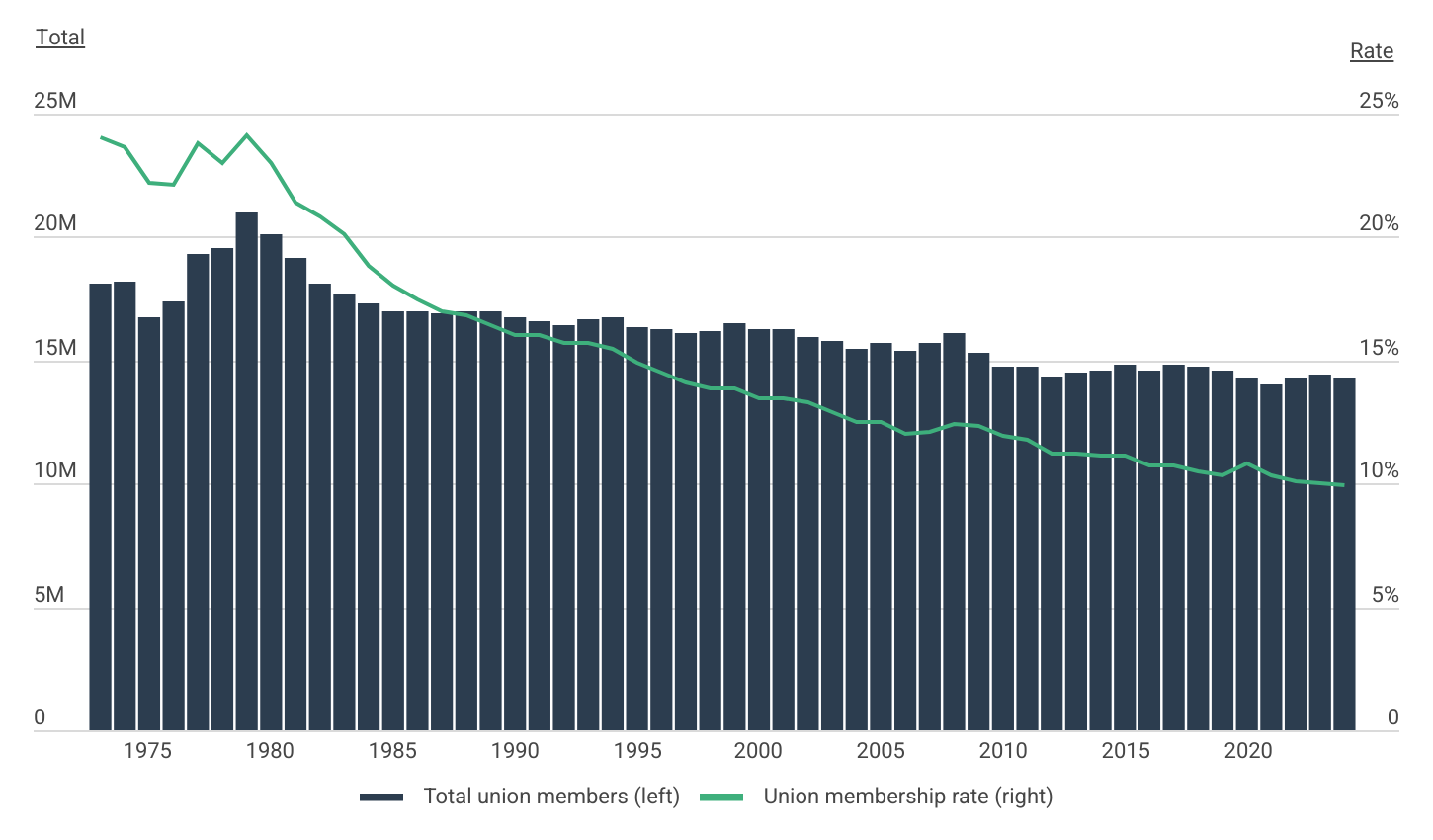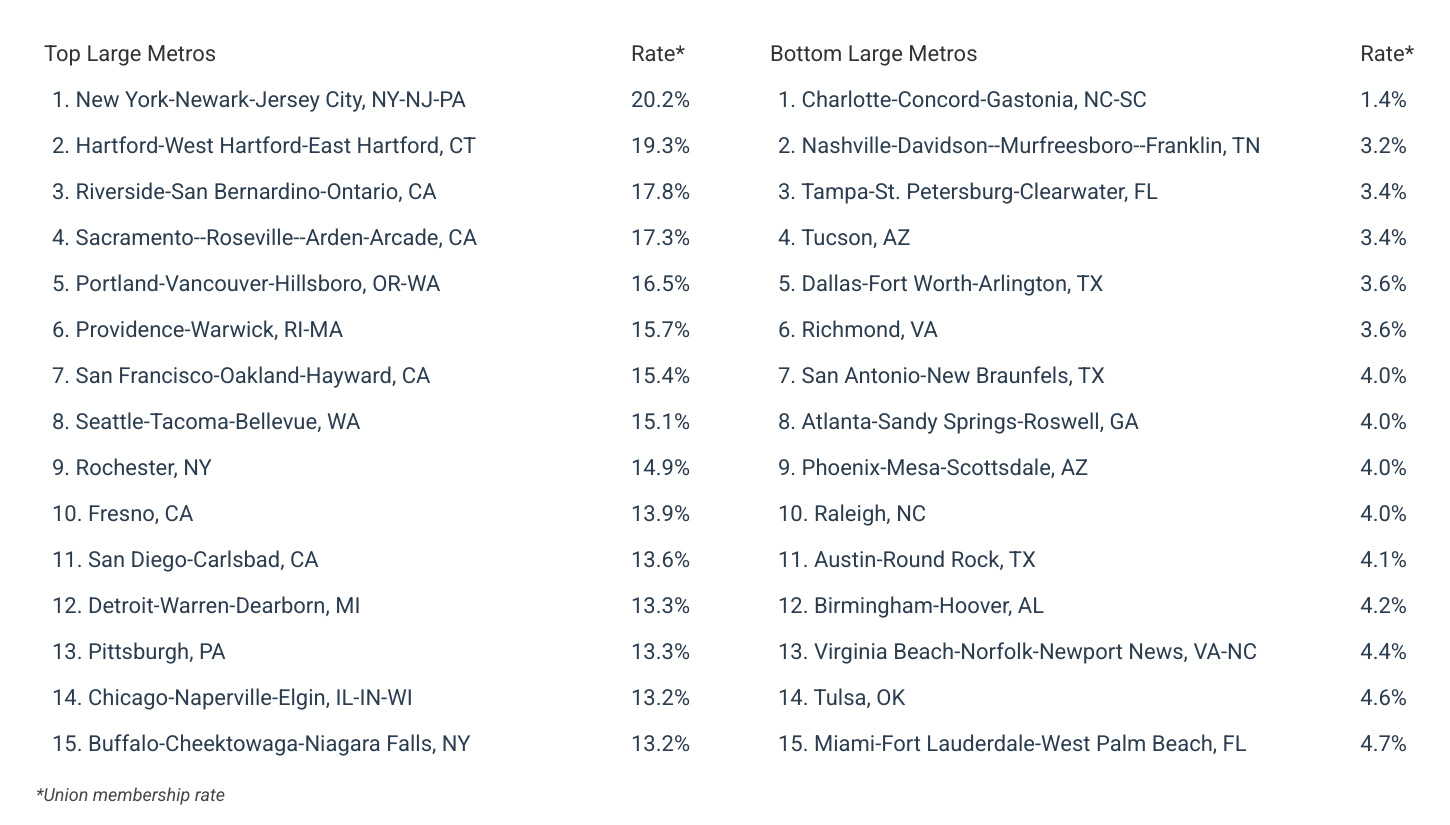Labor unions in the United States have experienced significant changes over the past several decades. Once a pillar for American workers, unions have seen their influence wane due to a combination of economic, political, and technological forces. Employer opposition, the rise of contract and gig-based work, globalization, and evolving labor laws have all contributed to a steady decline in union membership. These shifts have affected a wide range of occupations—from skilled trades like carpentry and plumbing to public-sector roles such as education and emergency response.
In recent years, however, interest in organized labor has experienced a resurgence. Growing public support for unions, high-profile organizing efforts at major corporations, and nationwide strikes in education, transportation, and entertainment have all signaled renewed momentum. At the same time, political developments continue to shape the landscape. In March 2025, President Donald Trump signed an executive order aimed at eliminating collective bargaining rights for more than one million federal employees—a move that union leaders view as part of a broader strategy to curtail organized labor across the country.
Against this backdrop, this report by Construction Coverage explores how union membership has changed over time, the differences in pay between union and non-union workers, and where unionization remains strongest at the state and city levels.
What Percentage of U.S. Workers Are Union Members?
Only 9.9% of American workers are union members, down from 24.1% in 1979

Source: Construction Coverage analysis of UnionStats data | Image Credit: Construction Coverage
Union membership in the United States has declined to its lowest point in decades. In 1979, unions represented 24.1% of the American workforce. By 2024, that share had fallen to just 9.9%, according to figures from the U.S. Bureau of Labor Statistics and UnionStats. In absolute terms, this represents a drop of roughly 6.7 million members—from a peak of 20.9 million in 1979 to around 14.2 million in 2024.
This contraction has reshaped the role of organized labor in the U.S. economy. While union presence remains relatively strong in certain public-sector roles and heavily unionized industries, much of the workforce now operates in environments where collective bargaining is less common. Yet despite their declining numbers, unionized workers continue to see notable advantages—particularly when it comes to wages and benefits—compared to their non-union counterparts.
Do Union Workers Earn More Than Non-Union Workers?
In 2024, union workers earned 17.5% more than non-union workers

Source: Construction Coverage analysis of BLS data | Image Credit: Construction Coverage
Despite their declining share of the workforce, unionized workers continue to enjoy a significant wage advantage over their non-union peers. According to data from the U.S. Bureau of Labor Statistics, full-time union workers earned a median of $1,337 per week in 2024. By contrast, full-time non-union workers earned $1,138 per week—a difference of approximately 17.5%. On an annual basis, this translates to more than $10,000 in additional earnings for the typical unionized worker.
This wage premium reflects the collective bargaining power that unions bring to the negotiating table. Rather than relying on individual discussions with employers, unionized employees are represented in contract negotiations that often result in better pay, more robust benefits, and stronger job protections. For many workers, union representation remains a key factor in achieving greater financial stability and upward mobility.
Regional Differences in Union Membership
Pacific and Northeastern states have the highest unionization rates

Source: Construction Coverage analysis of UnionStats data | Image Credit: Construction Coverage
Union membership rates vary widely across the United States. States in the Pacific and Northeast regions consistently report the highest levels of unionization, while many Southern and Plains states have lower rates.
As of 2024, Hawaii led the nation with a union membership rate of 26.6%, followed by New York (20.6%) and Alaska (17.6%). Other high-ranking states included Connecticut (16.5%), New Jersey (16.2%), Oregon (15.9%), Washington (15.9%), and Massachusetts (14.6%). These states are characterized by more union-friendly labor laws, strong public-sector union representation, and in many cases, a historical legacy of organized labor in industries such as construction, education, and public administration.
In contrast, many of the states with the lowest unionization rates are concentrated in the South and parts of the Mountain West. North Carolina (2.4%), South Dakota (2.7%), and South Carolina (2.8%) had the lowest union membership rates in the country, followed by Arkansas (3.6%), Utah (3.7%), and Arizona (3.7%). These states are all governed by so-called “right-to-work” laws, which prohibit mandatory union membership or dues as a condition of employment. Currently, 28 states have enacted right-to-work legislation, including nearly all states in the South, as well as parts of the Midwest and West.
These laws tend to weaken unions’ financial stability and bargaining power, which labor advocates argue reduces their effectiveness and contributes to declining membership. Meanwhile, states without right-to-work laws tend to maintain stronger union representation and higher rates of membership.
Below is a complete breakdown of union membership rates across the top and bottom cities and states. The analysis was conducted by Construction Coverage—a construction industry publication—using data from the U.S. Bureau of Labor Statistics and UnionStats. For complete results, refer to the original post on Construction Coverage: The Most Unionized Cities in America.
Union Membership Rates by City



Union Membership Rates by State

Methodology

Photo Credit: Blue Planet Studio / Shutterstock
To determine the most unionized locations in the U.S., researchers at Construction Coverage analyzed data from UnionStats.com and the U.S. Bureau of Labor Statistics. The researchers ranked states and metropolitan statistical areas according to total union members as a percentage of total employment. In addition to union membership, the researchers also included statistics on union representation, which is the share of workers whose terms of work are collectively negotiated (whether or not they are union members).
Only metropolitan statistical areas with available data were included in the analysis. Additionally, metro areas were grouped into the following cohorts based on population size:
- Small metros: less than 350,000
- Midsize metros: 350,000-999,999
- Large metros: 1,000,000 or more
For complete results, see The Most Unionized Cities in America on Construction Coverage.





